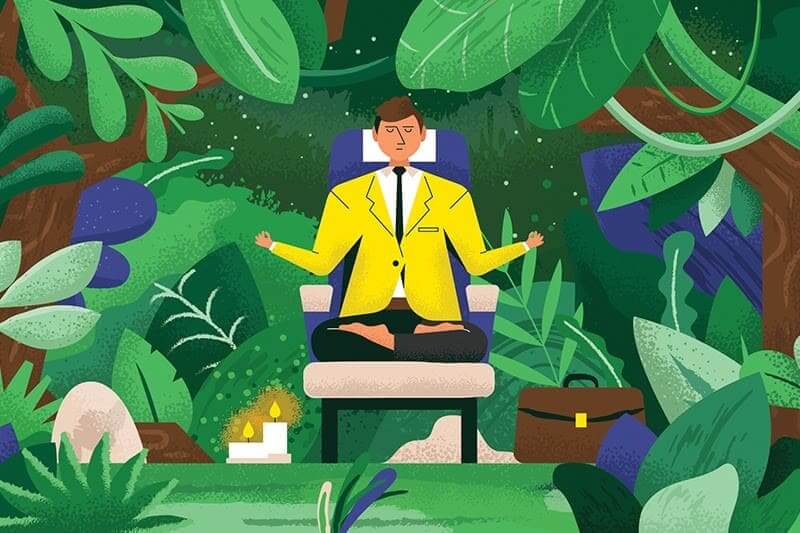If you are a designer or someone who writes code on a regular basis in any part of your professional life, you are no stranger to the stress that comes with it. Any type of creative work exercises your brain and being a professional designer is no exception. In this article we discuss How Can Meditation Help You Become a Better Designer?
No matter how superior your design skills are, work fatigue is rampant in the creative industry and you just can not escape it!
The best way to negate mental fatigue is to hold it by the horns and counter it with the most ancient technique to attain bliss- meditation!
Meditation has been in practice for hundreds of years. It was originally meant for decoding the understanding of the divine and esoteric forces of life.
Today, meditation is mostly used for relaxation and stress reduction. Hiring a web developer based on their skills is the norm, but the web developer has to work on his mental equilibrium by himself.
It is very much possible to develop a few aspects of the mind to attain mental freshness. Meditation improves concentration, helps you sleep better, and the very ability of awareness to positively enhance the mental state which will result in more efficiency in the professional tasks.

Table of Contents
How can designers benefit from meditation?
Imagine this!
Suppose you are busy designing a website and it is just not matching the expectations. You have spent countless hours dedicatedly with all the skills you have in your quiver.
But, something is missing! There is nothing more or new that you can do and now frustration is setting in.
You are not sure about your capabilities anymore and you are tired of scratching your head. But, the worst part is that you just can’t give up! You have to deliver the project on schedule.
Science says that we are at our creative best when our mind is tranquil. However, when you have a deadline looming in your head, it is not easy to quiet the panicked brain.
You have already gone through that niggling narrative: “I am gonna be late”, “I shall never finish”, “This really looks terrible”, etc
In such a scenario, meditation can offer help. Meditation influences the body in exactly the opposite ways of stress—by triggering the body’s relaxation response.
It rehabilitates the body to a calm state and helps the body to repair itself. It stabilizes the body and restricts further damage from the effects of stress.
When you are meditating, you can fixate your attention and nullify the web of jumbled thoughts that are crowding your mind and inducing stress.
This process may result in the much required emotional well-being that a designer needs to enhance his productivity.
When you know how to calm your mind and body, you have an effective approach to melting your stress away.
This refreshes you, makes you feel better, and gives you enough mental ammunition to face the pending challenges with renewed zeal.
If meditation is practiced regularly, it can help to achieve long-term resilience against stress.

3 Things to Keep in Mind About Meditation
1. Consistency is the key and not the duration
In simple words, it is better to meditate for ten minutes, six times per week than for 1 hour once a week.
Since you do not need any equipment or facility for meditation, you can do it at your office during your breaks.
Or, when you are feeling stressed while designing a web page, you can just do a 5-minute meditation just by sitting on your chair.
Short daily sessions are also more likely to make you stick to it regularly.
2. Practice matters, and not the “perfect practice”
Don’t bother yourself with that perfect position for meditation, how long you have to sit, or the time of the day. Just start! Once you begin, the other things will fall into place by itself.
Always remember that a wrong meditation is still better than NO meditation!
3. If you feel that your mind is getting diverted, that FEELING is important!
Meditation is challenging at times. Our mind is like a fluid in motion. So, if you NOTICE that the mind is wandering like a wild horse, that is a great thing- because you are AWARE of it!
This is what meditation is for.
When you are frustrated with your designing tasks, you are already in the midst of ten different kinds of thought process, tangled with each other.
To bring your focus back, you must be aware of the fact that what are the other thoughts that you are entangled with!
Closing Thoughts
Although meditation seeks to slow down the mind and the body in order to synchronize them, it helps designers to make new visual and conceptual connections in the longer run.
It allows them to take a pause, to breathe, and then take a more relaxed, considered approach to their daily work. Anxiety subsides and designers benefit from the creative decision making and a stress-free work life.
Once you start meditating, you will gradually see the results pouring in.
Join The Logo Community
We hope you have enjoyed this article about How Can Meditation Help You Become a Better Designer?.
If you have been looking to improve your documents or processes, or are just starting out and don’t have many of these key resources, you may want to check GrindCrew out!
Stop losing on revenue and increase your close rate. Get your clients hooked with your process and generate a stable income flow.
The kit is brilliant trust us! It’s everything you need in a nice package!
*TIP – We use and recommend GrindKit. This is every document you need to work remotely to land bigger clients. Save 20% off with our link and you won’t regret it Trust us!
Useful Links & Great Deals
- The Equipment We Use & Recommend
- Quality Design Bundles
- Get 2 Months free Skillshare
- Get an Exclusive 20% off Logo Package Express
- Learn Logo Design Online
Author’s Bio
Emily White is a veteran web designer at CSSChopper, a reputed web development company. She has a knack of writing blogs for the audience in her spare time. She also conducts workshops to combat stress-related problems in the modern work culture.
FAQ Section
How to meditate at home?
You can meditate either by sitting down or standing up, whichever feels the most comfortable to you. While meditating it’s always best to close your eyes and relax, drain your thoughts and focus your attention on your breathing inhale and exhale but making no effort to control your breath and simply breathe naturally.
The Types of meditation
There are different types of meditation including Metta meditation its goal is to cultivate the attitude of loving and kindness towards everything. The key with this form is to repeat the message multiple times, until the person feels the attitude of love and kindness. Progressive relaxation - is a type of body scan that starts with the feet working upwards to scan the body for tension and allow for release promoting general feelings of calmness and relaxation good for aiding better sleep. Mindfulness meditation - urges the person to remain aware and present at the moment, mindfulness encourages awareness of the persons existing surroundings. This form of meditation can be done anywhere calmly noticing the surroundings. Breath awareness meditation - is mindful that encourages mindful breathing slow and deeply while focusing and counting the persons breaths, similar to mindful meditation it offers similar benefits. Kundalini yoga - is a form of physical active meditation that combines movement with deep breathing and mantras. Normally carried out in classes but you can learn the poses to at home by yourself. Transcendental meditation - is a form of spiritual meditation. The person is seated and breaths very slowly. The aim of this form of meditation is to rise above your current state of being. You focus on a mantra or repeated set of words such as “I am calm and feel positive about my work” this helps with spiritual experience and higher mindfulness.
How do you clear your mind?
There are many ways to clear your mind, and you don’t necessarily need to focus on meditation to achieve this. For instance, talking to people is a great way to release what’s on your mind and having someone who is available to talk things through with is a great way to clear your mind. If you’re more of a private person you can write things down in a diary that you can reflect on later. Reading is a great way of calming your mind, and focusing on the content you are reading. Exercising in the gym or outdoors is another great form of mental release. Switching yourself off from work and stepping back from technology such as social media will help you focus better without the noise around you as a distraction. Meditation is also a great way to clear your mind even just by sitting at your desk or in a comfy chair and rest and empty your mind.
How long should I meditate for?
When you are new to meditation it is recommended you meditate for 5 to 10 minutes per day. You can do less if you prefer such as 1 minute or 2 minutes in the morning, and when you are comfortable sitting still and relaxing for those couple of minutes try increasing this time.



